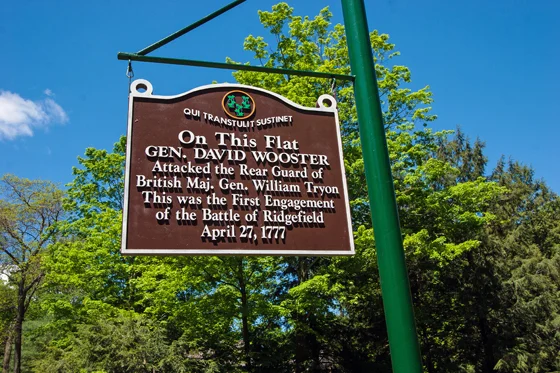Historic signs are everywhere!
I saw one when my colleague from WCSU and I when for a drink at Rosie Tomorrow’s in Danbury, CT
The sign had two historic facts that I wanted to check on and see if there were other markers or statues to the burning of Danbury and the hat manufacturing.
I found a boulder on Main Street in Danbury commemorates the burning of several local buildings by British forces who invaded the city on April 26, 1777.
I found a statue of Sybil Ludington next to the Danbury Library.
On the night of April 26, 1777, Colonel Henry Ludington, veteran of the French-Indian War, and commander of the militia in Duchess County, New York, (just across the state line from Danbury, Connecticut) received a messenger to his house. The British had attacked Danbury to disrupt the distribution of supplies to the Patriot Army. They destroyed a huge range of goods from 5000 shoes to more than 1000 tents.
Col. Ludington's militia, some 400 men, were at home. Sybil set off in the rain to warn the men.
She completed her mission around daybreak, covering nearly 40 miles—more than twice what Paul Revere had ridden. The militia was now ready to march to Danbury to confront the British Army.
For more information on the history of Sybil Ludington, see Vin Daquino's book Patriot Hero of the Hudson Valley: The Life and Ride of Sybil Ludington.
Sybil gets a lot of coverage and statues, but what about her father, Col Henry Ludington.
His grave stone at Maple Avenue Cemetery in Patterson, Putnam County, New York, is the only marker I can find for him.
Col. Ludington received his military training with the British army. He fought in the Seven Years War (1756-1763), but when the Revolution started, he switched sides. He was a regional commander of local militia. He was also a member of the Committee of Safety who administered revolutionary justice as they alone defined it. He also was privy to the spying missions of Enoch Crosby.
However, there are markers on the road that Col. Ludington and his militia took to Connecticut about his mission. It’s a 17-mile hike from Fredericksburg (today: Kent, New York) to the Connecticut border. Yet, Col. Ludington and his troops receive a message that diverted them to Ridgefield, Connecticut where the battle was unfolding.
Meanwhile in Danbury, the British under General Tyron had finished destroying the stockpile of supplies and setting fire to Danbury.
A boulder on Main Street in Danbury commemorates the burning of several local buildings by British forces who invaded the city on April 26, 1777.
Earlier conjecture was that General Tyron’s original mission was to continue to Saratoga to link up with British General Burgoyne. Historians note that since we won the battle of Saratoga, the French decided to join us in a military alliance. In reality, The General had one mission – to burn Danbury.
However, the Patriots under Generals Wooster, Silliman and Arnold were advancing against General Tyron. And so, he decided it was time to retreat back to his ships. At this point Col Ludington and his men joined the pursuit. The forces would meet at the Battle of Ridgefield.
General Wooster, a one-time British Army officer who switched sides when the revolution started, surprised the British with an initial engagement on their rear column, but the British were ready for the second attack. His troops received heavy artillery fire. While not aimed at General Wooster or his troops, one cannon ball is still lodged in the Keller Tavern which is now a museum.
Consequently, General Wooster died three weeks after a musket ball struck him in the back.
He has a red obelisk erected to him by the Freemasons in the Wooster Cemetery in Danbury.
The British escaped the road block that the patriots had set up in Danbury and made it back to their ships. There is a cannon memorial at Combo Beach in Westport. These cannons were not part of the engagement.
Our road today stretched from Ludingtonville to Danbury to Ridgefield to Westport. I hope you enjoyed the ride.
And I found a statue to the hat manufacturing monopoly that was Danbury, again next to the Danbury town hall. I will discuss that statue in another newsletter.













